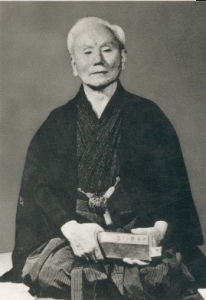Shotokan Karate – An introduction
 Karate means, way of the empty hand and contrary to its image is a non aggressive pastime which can be enjoyed by anyone of any age and ability. Although a fighting system it is the blocks you will learn first, closely followed by punching and kicking techniques. Karate is not only a physical pastime but also promotes discipline and self control resulting in peace of mind and self confidence.
Karate means, way of the empty hand and contrary to its image is a non aggressive pastime which can be enjoyed by anyone of any age and ability. Although a fighting system it is the blocks you will learn first, closely followed by punching and kicking techniques. Karate is not only a physical pastime but also promotes discipline and self control resulting in peace of mind and self confidence.
Shotokan is the most popular of the Japanese karate systems, it was founded by Gichin Funakoshi and is influenced directly by the Okinawan style of Shuri-te it is characterised by powerful linear movements and deep, strong stances.
Shotokan is often regarded as a ‘hard’ and ‘external’ martial art because it is taught that way to beginners and coloured belts to develop strong basic techniques and stances. Strength and power are demonstrated instead of slower, more flowing motions, which come later to those who progress to brown and black belt level, where they develop a much more fluid style that incorporates grappling and some take down techniques. It is also renowned for dealing with conflict, quickly and decisively.
Shotokan Karate – A brief history
 Shotokan is a style of karate, developed from various martial arts by Gichin Funakoshi (1868–1957). Gichin was born in Okinawa and is widely credited with popularizing “karate do”. Through a series of public demonstrations, and by promoting the development of university karate clubs. Funakoshi had trained in both of the popular styles of Okinawan karate of the time: Shorei-ryu and Shorin-ryu. Under his own teacher and mentor Yasutsune Itosu.
Shotokan is a style of karate, developed from various martial arts by Gichin Funakoshi (1868–1957). Gichin was born in Okinawa and is widely credited with popularizing “karate do”. Through a series of public demonstrations, and by promoting the development of university karate clubs. Funakoshi had trained in both of the popular styles of Okinawan karate of the time: Shorei-ryu and Shorin-ryu. Under his own teacher and mentor Yasutsune Itosu.
Itosu served as a secretary to the last king of the Ryuku Kingdom until Japan abolished the Okinawa-based native monarchy in 1879. In 1901, he was instrumental in getting karate introduced into Okinawa’s schools. In 1905, Itosu was a part-time teacher of To-de* at Okinawa’s First Junior Prefectural High School. It was here that he developed the systematic method of teaching karate techniques that are still in practice today. He created and introduced the Pinan forms (Heian in Japanese).
After years of study in both styles of Shorei-ryu and Shorin-ryu, Funakoshi created a simpler system that combined the ideals of the two. In 1924, Funakoshi adopted the Kyu / Dan rank system and the uniform developed by Kano Jigoro, the founder of judo. This system uses coloured belts to indicate rank. Originally, karate had only three belt colours: White, Brown, and Black. There are now at least ten belts from beginner to Black belt.
The name Shotokan was the name of the first official dojo built by Gichin Funakoshi, in 1936 at Mejiro, and destroyed in 1945 as a result of allied bombing. Funakoshi practiced calligraphy and signed his work with his pen name, “shoto”, meaning “pine-waves” (the movement of pine needles when the wind blows through them), which he used in his poetic and philosophical writings and messages to his students. The Japanese word kan, means “house” or “hall”. Hence, the school where he taught came to be known as shoto’s school. Today, his style of karate is one of the major karate systems practised throughout the world.
In honor of their sensei, Funakoshi’s students created a sign reading shōtō-kan, which they placed above the entrance of the hall where Funakoshi taught. Gichin Funakoshi never gave his system a name, just calling it karate. Funakoshi had many students at the university clubs and outside dojos, who continued to teach karate after his death in 1957. So today, there is no single “Shotokan school”, although they all bear Funakoshi’s influence. Being the largest and most widely practiced style of Karate, Shotokan is considered a traditional and influential form of karate do.
*Naha-te, Shuri-te and Tomari-te belong to a family of martial arts that were collectively defined as Tode-jutsu or To-de.